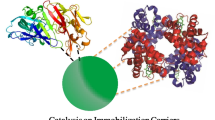Abstract
A study of the cross-linking of β-galactosidase on magnetic beads is reported here. The magnetic beads were prepared from artemisia seed gum, chitosan, and magnetic fluid in the presence of a cross-linking regent (i.e., glutaraldehyde). The reactive aldehyde groups of the magnetic beads allowed the reaction of the amino groups of the enzymes. The animated magnetic beads were used for the covalent immobilization of β-galactosidase. The effect of various preparation conditions on the activity of the immobilized β-galactosidase, such as immobilizing time, amount of enzyme, and the concentration of glutaraldehyde, were investigated. The influence of pH and temperature on the activity and the stability of the enzyme, both free and immobilized, have been studied. And o-nitrophenyl-β-d-galactopyranoside (ONPG) was chosen as a substrate. The β-galactosidase immobilized on the magnetic beads resulted in an increase in enzyme stability. Optimum operational temperature for immobilized enzyme was 10 °C higher than that of free enzyme and was significantly broader.






Similar content being viewed by others
References
Wu, S. G., Liu, B. L., & Li, S. L. (2005). Behaviors of enzyme immobilization onto functional microspheres. International Journal of Biological Macromolecules, 37(5), 263–267. doi:10.1016/j.ijbiomac.2005.12.007.
Yagiz, F., Kazan, D., & Akin, A. N. (2007). Biodiesel production from waste oils by using lipase immobilized on hydrotalcite and zeolites. Chemical Engineering Journal, 134(1–3), 262–267. doi:10.1016/j.cej.2007.03.041.
Li, S. J., Hu, J., & Liu, B. L. (2004). Use of chemically modified PMMA microspheres for enzyme immobilization. Biosystems, 77(1–3), 25–32. doi:10.1016/j.biosystems.2004.03.001.
Lim, L. H., Macdonald, D. G., & Hill, G. A. (2003). Hydrolysis of starch particles using immobilized barley α-amylase. Biochemical Engineering Journal, 13(1), 53–62. doi:10.1016/S1369-703X(02)00101-8.
Aksoy, S., Tumturk, H., & Hasirci, N. (1998). Stability of a-amylase immobilized on poly (methyl methacrylate–acrylic acid) beads. Journal of Biotechnology, 60(1–2), 37–46. doi:10.1016/S0168-1656(97)00179-X.
Lei, H., Wang, W., Chen, L. L., Li, X. C., Yi, B., & Deng, L. (2004). The preparation and catalytically active characterization of papain immobilized on magnetic composite beads. Enzyme and Microbial Technology, 35(1), 15–21. doi:10.1016/j.enzmictec.2004.03.007.
Alencar de Queiroz, A. A., Vitolo, M., De Oliveira, R. C., & Higa, O. Z. (1996). Invertase immobilization onto radiation-induced graft copolymerized polyethylene pellets. Radiation Physics and Chemistry, 47(6), 873–880. doi:10.1016/0969-806X(95)00181-V.
Guo, Z., Bai, S., & Sun, Y. (2003). Preparation and characterization of immobilized lipase on magnetic hydrophobic beads. Enzyme and Microbial Technology, 32(7), 776–782.
Obon, J. M., Castellar, M. R., Iborra, J. L., & Manjon, A. (2000). β-Galactosidase immobilization for milk lactose hydrolysis: a simple experimental and modelling study of batch and continuous reactors. Biochemical Education, 28(3), 164–168. doi:10.1016/S0307-4412(99)00097-7.
Quinn, Z. K., & Zhou, X. D. (2001). Effects of temperature and pH on the catalytic activity of the immobilized β-galactosidase from Kluyveromyces lactis. Biochemical Engineering Journal, 9(1), 33–40. doi:10.1016/S1369-703X(01)00118-8.
Tanriseven, A., & Dogan, S. (2002). A novel method for the immobilization of β-galactosidase. Process Biochemistry, 38(1), 27–30. doi:10.1016/S0032-9592(02)00049-3.
Zhang, J., Zhang, S. T., Wang, Y. P., & Zeng, J. Y. (2007). Composite magnetic microspheres: preparation and characterization. Journal of Magnetism and Magnetic Materials, 309(2), 197–201. doi:10.1016/j.jmmm.2006.06.035.
Zhang, J., Zhang, S. T., Wu, G. P., Wang, W. Q., & Gao, S. F. (2007). An investigation of two kinds of magnetic chitosan composite microspheres. Journal of Bioactive and Compatible Polymers, 22(4), 429–441. doi:10.1177/0883911507079967.
Giacomini, C., Villarino, A., Fraguas, L. F., & Viera, F. B. (1998). Immobilization of β-galactosidase from Kluyveromyces lactis on silica and agarose: comparison of different methods. Journal of Molecular Catalysis, B, Enzymatic, 4(5–6), 313–327. doi:10.1016/S1381-1177(98)00071-X.
Hernaiz, M. J., & Crout, D. H. G. (2000). Immobilization/stabilization on Eepergit C of the β-galactosidase from B. circulans and an α-galactosidase from Aspergillus oryzae. Enzyme and Microbial Technology, 27(1–2), 26–32. doi:10.1016/S0141-0229(00)00150-2.
Bayramoglu, G., Tunali, Y., & Arica, M. Y. (2007). Immobilization of β-galactosidase onto magnetic poly(GMA-MMA) beads for hydrolysis of lactose in bed reactor. Catalysis Communications, 8(7), 1094–1101. doi:10.1016/j.catcom.2006.10.029.
Sanjay, G., & Sugunan, S. (2006). Enhanced pH and thermal stabilities of invertase immobilized on montmorillonite K-10. Food Chemistry, 94(4), 573–579. doi:10.1016/j.foodchem.2004.12.043.
Xu, F. J., Cai, Q. J., Li, Y. L., et al. (2005). Covalent immobilization of glucose oxidase on well-defined poly(glycidyl methacrylate)–Si(111) hybrids from surface-initiated atom-transfer radical polymerization. Biomacromolecules, 6(2), 1012–1020. doi:10.1021/bm0493178.
Dinnella, C., Monteleone, E., Farenga, M. F., et al. (2004). The use of enzymes for thermal process monitoring: modification of milk alkaline phosphatase heat resistance by means of an immobilization technique. Food Control, 15(6), 427–433. doi:10.1016/S0956-7135(03)00117-8.
Author information
Authors and Affiliations
Corresponding author
Rights and permissions
About this article
Cite this article
Zhang, S., Gao, S. & Gao, G. Immobilization of β-Galactosidase onto Magnetic Beads. Appl Biochem Biotechnol 160, 1386–1393 (2010). https://doi.org/10.1007/s12010-009-8600-5
Received:
Accepted:
Published:
Issue Date:
DOI: https://doi.org/10.1007/s12010-009-8600-5




